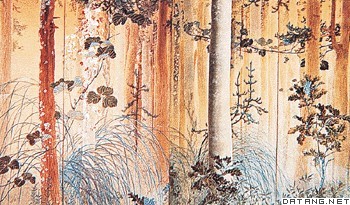1) Japanese Painting


日本画
1.
This essay begins with the evolution of Japanese painting from its tradition to modernity; discuss a series of creative innovation taking place in Japanese painting and its modern development in terms of material and forms; analyzes its impact on Chinese present meticulous painting drawing on the basis of current situation and developing environment in ch.
本文从传统日本画向现代日本画的变革谈起,阐述了日本画一系列的创造变革和现代日本画在材料和形式语言方面的发展,结合中国当代工笔画的现状与发展环境,分析了现代日本画对中国当代工笔重彩画的影响。
2) Japanese animation


日本动画
1.
First of all, it wasproduced that Chinese animation and Japanese animation are all underthe influence of western cartoon, but they have their own characteristicsunder the same background.
中国动画片尽管走过了一段辉煌时期,但理论上鲜少有人论及,是影视研究的新领域,日本动画在二十世纪末则以强大的竞争力鲸吞了中国市场。
2.
However, although having great influences in culture and much profit in economic, Japanese animation can\'t sidestep its themes on violence, war and Militarism.
日本动画片以其精彩的故事情节、错落有致的叙事结构、丰富的人物形象和语言、多变的绘画色彩和风格等被广大的观众所认知和喜爱,特别是得到了全世界越来越多的青少年的推崇。
3.
Chinese and the Japanese animation has not given up in the respective developing process to the unique individuality pursue.
首先采用由点及面的方式,通过对中日动画具体作品的分析,找出其带有普遍性和代表性的艺术风格特征,并通过中日动画艺术横向比较,分析研究中日动画艺术风格的特点;然后由表及里,揭示动画艺术及其相关艺术形式之间的横向联系;再次,通过纵向挖掘,进一步比较中日动画艺术风格形成的文化基因,分析中国传统民间文学、儒家思想以及“物哀”思想、“深层文化”对中日动画艺术风格所产生的深远影响,并在此基础上总结出日本动画艺术对中国动画艺术发展的启示。
3) Japanese Literati Painting


日本文人画
1.
This thesis on Japanese Literati Painting in Edo periodand (1615-1867) anatomizes the art style evolvement and inspiration source of the representative Japanese Literati Painter including GION Nankai, SAKAKI Hyakusen, YANAGISAWA Kien, IKE-NO Taiga, YOSA Buson, URAGAMI Gyokudou, AOKI Mokubee, TANOMURA Chikuden, etc.
本论文以18世纪中后期日本江户时代(1615-1867)文人画作为研究对象,通过分析祗园南海、彭城百川、柳泽淇园、池大雅、与谢芜村、浦上玉堂、青木木米、田能村竹田等八位日本文人画代表性画家的风格演变、师承关系的分析,系统梳理与阐释了日本文人画本土化的演进历程,并通过日本文人画与中国文人画在画家身份、文人画题材与功能、笔墨与色彩等方面的比较,在参照性的视野中深入厘析了日本文人画的创造性特点及其体现出的个性化的民族艺术特色。
4) Japan
[英][dʒə'pæn] [美][dʒə'pæn]


日本
1.
The Development Condition of Forerunner Cutting Technique and Material of Hardware and Cutting-tools in Japan;
日本先进切削技术和五金刀具材料的发展状况
2.
Study on Experiences of Protecting and Treating Biwa Lake of Japan;


日本琵琶湖环境保护与治理经验
3.
The environmental protection technologies of power transformation facility in Japan;


日本变电设备的环境保护技术
5) Japanese
[英][ˌdʒæpə'ni:z] [美][ˌdʒæpə'niz]


日本
1.
The Conditions of the Japanese Food System and Its Research Progress;


日本食品系统的状况及其研究进展
2.
Study on the Cultivation of Japanese Innovative Talents;


日本博士生培养模式研究
3.
Sero-epidemiological Survey on Japanese Encephalitis at Pig Farms Registered in Zhuhai;


珠海市部分注册猪场日本脑炎调查研究
6) Charybdis japonica


日本
1.
Effects of Accumulated Bleaching Powder on Ultrastructure of four Tissues in Charybdis japonica;
漂白粉蓄积对日本4种组织超微结构的影响
2.
The effects of heavy metal ions on the hisological structures of gill and hepatopancreas of Charybdis japonica were observed by means of a light microscope in 15 days experiment.
在实验生态条件下研究了重金属离子(Cu2+、Pb2+、Hg2+、Cd2+)对日本鳃丝和肝胰脏显微结构(15d)的影响。
补充资料:日本画
| 日本画 Nihoga 日本的传统画种。明治维新以后西方绘画传入日本,西洋画兴起,为与其相区别,故将使用传统材料和技法的日本民族绘画称为日本画。 日本画源远流长,具有2000年以上的历史。在其发展中曾先后受到中国和西方绘画的冲击与影响,它在不同的历史时期,具有不同的名称和美学内涵,如奈良时代的唐绘、平安时代的大和绘、镰仓至室町时代的汉画、安士桃山时代的障屏绘、江户时代的日本文人画与浮世绘等。明治维新的实施,输入了西方绘画的观念和技法,使日本画受到了极大冲击,并促其进行了大胆的创新。第二次世界大战之后,受西方现代主义思潮的影响,日本画在工具材料、表现形式、题材内容及审美观念上都发生了很大的变化,并逐渐走向世界。日本画所使用的工具、材料有纸、绢、毛笔、墨、颜料(日本所独产),其画有水墨和彩色两种,其画幅形式有绘卷物、册页、袄绘、屏风绘、壁绘、扇面等。
|
说明:补充资料仅用于学习参考,请勿用于其它任何用途。
参考词条
